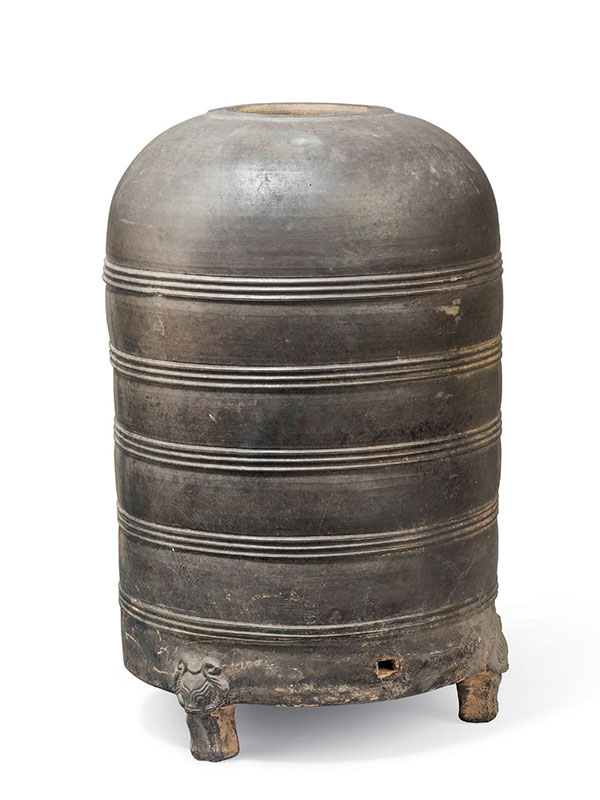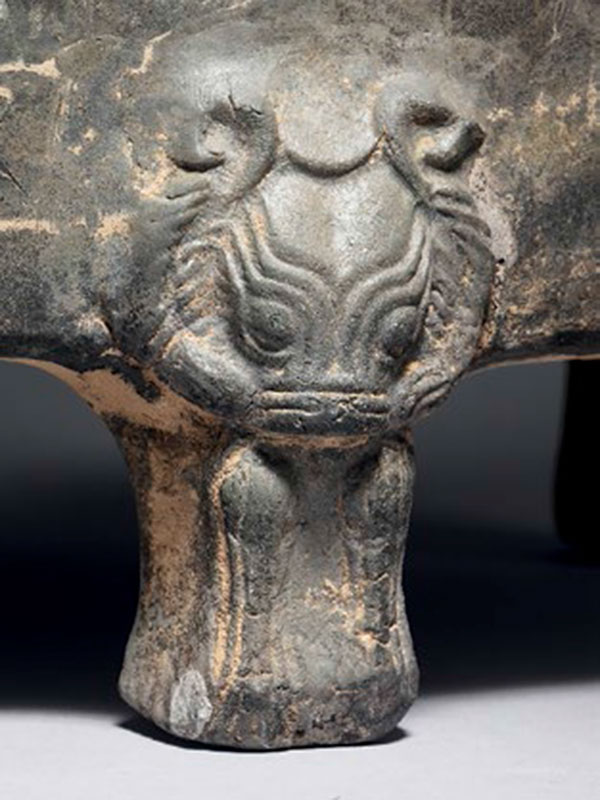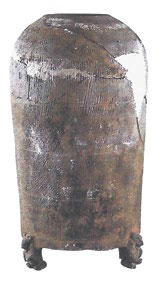Pottery granary jar
A large cylindrical pottery model of a granary supported on three bear-form feet. The granary’s domed top has a central aperture, which is surrounded by a lipped rim. The straight sides are mainly undecorated, save for five sets of three horizontal linear bands, which are incised into the main body. Each of the bear-shaped feet is moulded in minute detail with bulging eyes, full mane and upper limbs. The grey pottery jar is burnished, giving the material an iridescent silvery sheen.
Pottery made during the Han dynasty provides a valuable insight into the social and financial context of China. This unusually shaped earthenware jar reflects the ideal of comfortable living in the agrarian society of the time, and granary jars used to store grains were a symbol of wealth. Such jars were made as part of a larger group and sometimes bore the name of the crop, to help identify the contents. Granary jars supported on bear-form feet are not unknown in the Han dynasty, since bears symbolise bravery and strength. According to Welch, “bears seem to have been very popular figures in the Han zoomorphic repertoire but were little used thereafter.”[1] A closely comparable granary jar with a pale green glaze, formerly in the Charles B. Hoyt collection, is now in the Museum of Fine Arts, Boston.[2] Another comparable granary jar with more naturalistic bear feet and cord-impressed decoration was discovered in 2003 in a mural tomb dating to the Xinmang regime (9 – 23 AD) in Yintun, Luoyang province (fig. 1).[3]
Provenance: private collection, Europe
- Welch, P. B. Chinese Art- A Guide to Motifs and Visual Imagery, Tuttle Publishing, Singapore, 2012, p. 114
- Tomita, K. The Charles B. Hoyt Collection: Memorial Exhibition,Museum of Fine Arts, Boston, 1952, no. 26, p. 7
- State Administration of Cultural Heritage, Major Archaeological Discoveries in China 2003, Cultural Relics Publishing House, Beijing, 2004, p. 103
陶倉
漢 西元前206年 – 西元220年
高:37.5 公分 寬:22.3 公分
泥質灰陶倉,素胎無釉,圓筒柱狀,直腹,於肩部向內收束,上開圓孔,平底,下承熊首三足。
陶倉腹側以五道三線弦紋平均分隔。各足模印製成熊首狀,炯然雙目、鬃毛與上肢均清晰可見。
漢代陶倉多為隨葬明器,不僅呈現當時農耕社會之生活情態,亦提供後世研究其社經狀況線索。
陶倉多見製成縮型屋瓦房舍,熊足力舉圓筒陶倉則反映出漢人對熊力大無比之崇尚。洛陽地區漢
墓即有類似陶倉出土,美國波士頓美術館亦有類似藏品。
來源: 歐洲私人收藏




